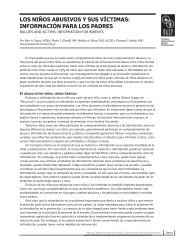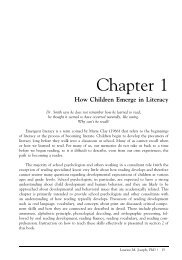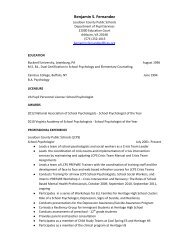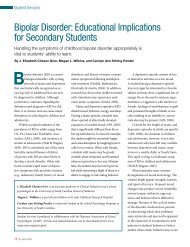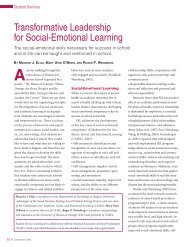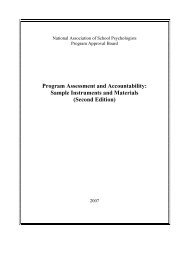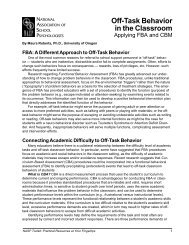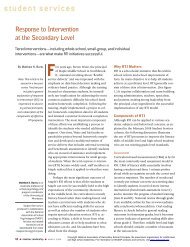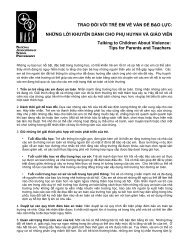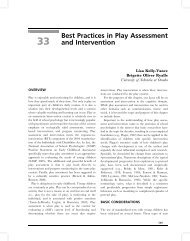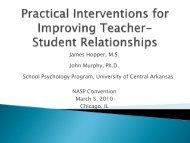Self-Concept and Self-Esteem in Adolescents - National Association ...
Self-Concept and Self-Esteem in Adolescents - National Association ...
Self-Concept and Self-Esteem in Adolescents - National Association ...
Create successful ePaper yourself
Turn your PDF publications into a flip-book with our unique Google optimized e-Paper software.
Student Services<br />
persist despite a wealth of empirical evidence<br />
that “self-esteem per se is not the<br />
social panacea that many people once<br />
hoped it was” (Baumeister, Campbell,<br />
Krueger, & Vohs, 2003, p. 38).<br />
<strong>Self</strong>-concept <strong>and</strong> academic achievement.<br />
<strong>Self</strong>-concept is frequently positively<br />
correlated with academic performance,<br />
but it appears to be a consequence<br />
rather than a cause of high achievement<br />
(Baumeister et al., 2003). This suggests<br />
that <strong>in</strong>creas<strong>in</strong>g students’ academic skills<br />
is a more effective means to boost their<br />
self-concept than vice versa.<br />
<strong>Self</strong>-concept <strong>and</strong> aggression. Another<br />
popular assumption is that aggressive<br />
students have low self-concept <strong>and</strong><br />
use aggression as a means of rais<strong>in</strong>g it.<br />
Substantial research contradicts this assumption,<br />
show<strong>in</strong>g that many aggressive<br />
students express adequate, if not <strong>in</strong>flated,<br />
self-concept (Baumeister et al., 2003).<br />
12 PL February 2007<br />
Advertisement<br />
<strong>Self</strong>-concept, depression, <strong>and</strong> use<br />
of illegal substances. Low self-concept<br />
is often considered a def<strong>in</strong><strong>in</strong>g<br />
characteristic of depression, but the<br />
evidence for this is weak. Similarly,<br />
although some evidence suggests that<br />
low self-concept may be a weak risk<br />
factor for smok<strong>in</strong>g <strong>in</strong> girls, the relationship<br />
between self-concept <strong>and</strong> the<br />
use of alcohol <strong>and</strong> illegal drugs has<br />
little support (Baumeister et al., 2003).<br />
Baumeister et al. (2003) suggest<br />
that self-concept is “not a major predictor<br />
or cause of almost anyth<strong>in</strong>g”<br />
(p. 37). Pr<strong>in</strong>cipals are advised not to<br />
focus on self-concept <strong>in</strong> hopes of prevent<strong>in</strong>g<br />
or remediat<strong>in</strong>g children’s academic<br />
or <strong>in</strong>terpersonal problems but<br />
rather to focus on build<strong>in</strong>g students’<br />
competencies <strong>and</strong> self-perceptions,<br />
which <strong>in</strong> turn will promote their selfconcept<br />
<strong>and</strong>, ultimately, self-esteem.<br />
Prevent<strong>in</strong>g Low <strong>Self</strong>-<strong>Concept</strong><br />
Effective prevention targets the primary<br />
antecedents of self-worth, namely perceived<br />
success <strong>in</strong> areas <strong>in</strong> which students<br />
desire success <strong>and</strong> approval from significant<br />
others. Although these two factors<br />
are highly related, excesses <strong>in</strong> one area<br />
cannot compensate for deficits <strong>in</strong> the other<br />
because the effects are additive rather<br />
than compensatory (Harter, 1999).<br />
Promot<strong>in</strong>g competence <strong>in</strong> doma<strong>in</strong>s<br />
of importance. To view themselves positively,<br />
students must feel competent <strong>in</strong><br />
doma<strong>in</strong>s that they deem important. Two<br />
doma<strong>in</strong>s that educators greatly <strong>in</strong>fluence<br />
are academics <strong>and</strong> behavior. For students<br />
who highly value these two doma<strong>in</strong>s—<br />
most adolescents—steady messages of<br />
academic <strong>and</strong> behavioral <strong>in</strong>competence<br />
(e.g., poor grades, retention, public reprim<strong>and</strong>s,<br />
<strong>and</strong> suspension) are likely to<br />
result <strong>in</strong> low self-concept.<br />
<strong>Self</strong>-perceived physical appearance<br />
has the strongest relationship to overall<br />
self-esteem, whereas self-perceived athletic<br />
competence has the weakest relationship.<br />
Given adolescents’ tendency to<br />
base their perceptions of attractiveness<br />
on media figures, schools should help<br />
students underst<strong>and</strong> that it is unrealistic<br />
<strong>and</strong> unhealthy to adopt such st<strong>and</strong>ards<br />
<strong>and</strong> should re<strong>in</strong>force healthier values<br />
(Harter, 1999).<br />
Perceptions of competence <strong>in</strong> doma<strong>in</strong>s<br />
that are valued by significant others<br />
also contribute to overall self-esteem.<br />
Parents often value scholastic competence<br />
<strong>and</strong> behavioral conduct, whereas<br />
peers often value physical appearance,<br />
social competence, <strong>and</strong> athletic competence.<br />
Students may feel <strong>in</strong>competent <strong>in</strong><br />
doma<strong>in</strong>s valued by others without necessarily<br />
feel<strong>in</strong>g bad about themselves: selfesteem<br />
may be protected if students feel<br />
competent <strong>in</strong> areas that they value <strong>and</strong><br />
discount the importance of the doma<strong>in</strong>s



